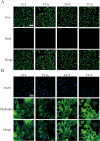Ta-Ag Coatings on TC4: A Strategy to Leverage Bioelectric Microenvironments for Enhanced Antibacterial Activity
- PMID: 40223638
- PMCID: PMC11995244
- DOI: 10.1002/biot.70000
Ta-Ag Coatings on TC4: A Strategy to Leverage Bioelectric Microenvironments for Enhanced Antibacterial Activity
Abstract
Dental implant-related infections are serious complications after surgery that can results in loosening or even complete loss of the implant. Although endogenous electric fields (EEF) play an integral role in the human body, current methods involving external electrical stimulation are invasive and not suitable for clinical application. In this study, we using DC magnetron sputtering, investigates the effects of tantalum-silver (Ta-Ag) coatings on titanium alloy (TC4) surfaces, focusing on their potential to influence EEF that enhances antibacterial activity In this design, Ta-Ag configuration effectively increased the surface potential difference of TC4, and furthermore, promoting Ta/Ag ions release and reducing bacterial adhesion. The study concludes that the Ta-Ag coating, particularly the TT/A implant, promotes a stable EEF, enhancing the long-term antibacterial and osteogenic properties of implants. This work provides a promising strategy for developing advanced implant materials with improved clinical efficacy.
Keywords: Ta‐Ag coating; antibacterial; charge transfer; endogenous electric fields; osteointegration.
© 2025 The Author(s). Biotechnology Journal published by Wiley‐VCH GmbH.
Conflict of interest statement
The authors declare no conflicts of interest.
Figures





References
-
- Daubert D. M., Weinstein B. F., Bordin S., Leroux B. G., and Flemmig T. F., “Prevalence and Predictive Factors for Peri‐Implant Disease and Implant Failure: A Cross‐Sectional Analysis,” Journal of Periodontology 86, no. 3 (2015): 337–347. - PubMed
-
- Vagia P., Papalou I., Burgy A., Tenenbaum H., Huck O., and Davideau L., “Association Between Periodontitis Treatment Outcomes and Peri‐Implantitis: A Long‐Term Retrospective Cohort Study,” Clinical Oral Implants Research 32, no. 6 (2021): 721–731. - PubMed
-
- Hu C., Lang N. P., Ong M. M.‐A., Lim L. P., and Tan W. C., “Influence of Periodontal Maintenance and Periodontitis Susceptibility on Implant Success: A 5‐year Retrospective Cohort on Moderately Rough Surfaced Implants,” Clinical Oral Implants Research 31, no. 8: 727–736. - PubMed
MeSH terms
Substances
LinkOut - more resources
Full Text Sources
Medical

